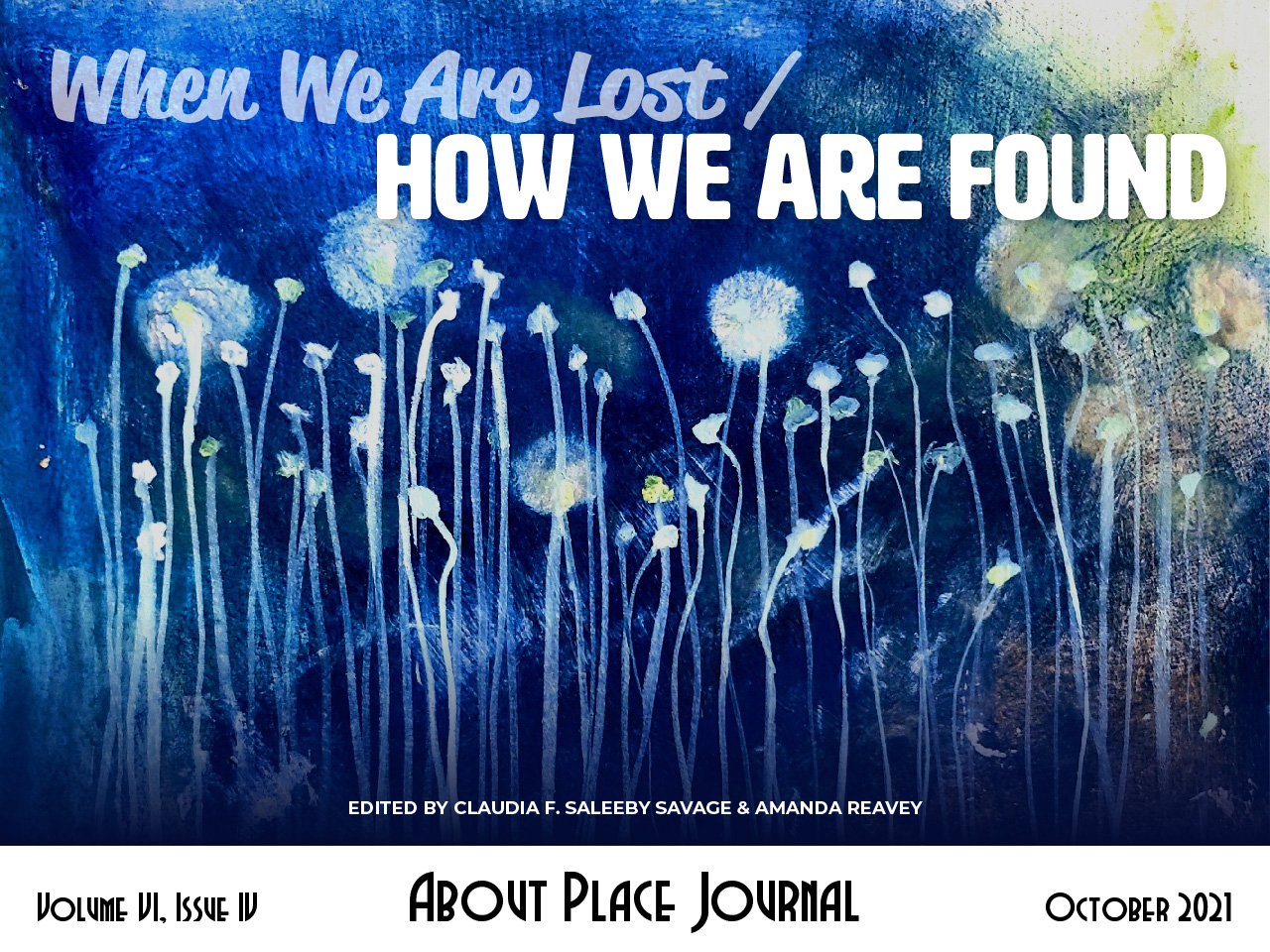In elementary school, I was captivated by the beauty Japanese-American gardeners had created in my suburb of Orange County, California. There, in the front yard of the couple’s ranch-style home, was a karesansui niwa—a dry garden. Instead of lawn, the yard had a gravel stream edged by boulders, promontories of juniper and sago palm, and a replica of Mt. Fuji. Nearly as high as the eaves, the mountain was capped with mosaics of cloud and drifts of snow. From the driveway, a path meandered toward the mountain, crossing a small red moon bridge and ending at a bench shaded by a parasol-shaped roof. I longed to sit on that bench. The yard was unlike any I’d ever encountered, completely different from the anonymous rectangles of lawn and sheared hedges that were everywhere but cherished nowhere in particular. The karesansui garden was infused with love and reverence for a place. The distance to the place didn’t seem to matter; the feeling for it did.
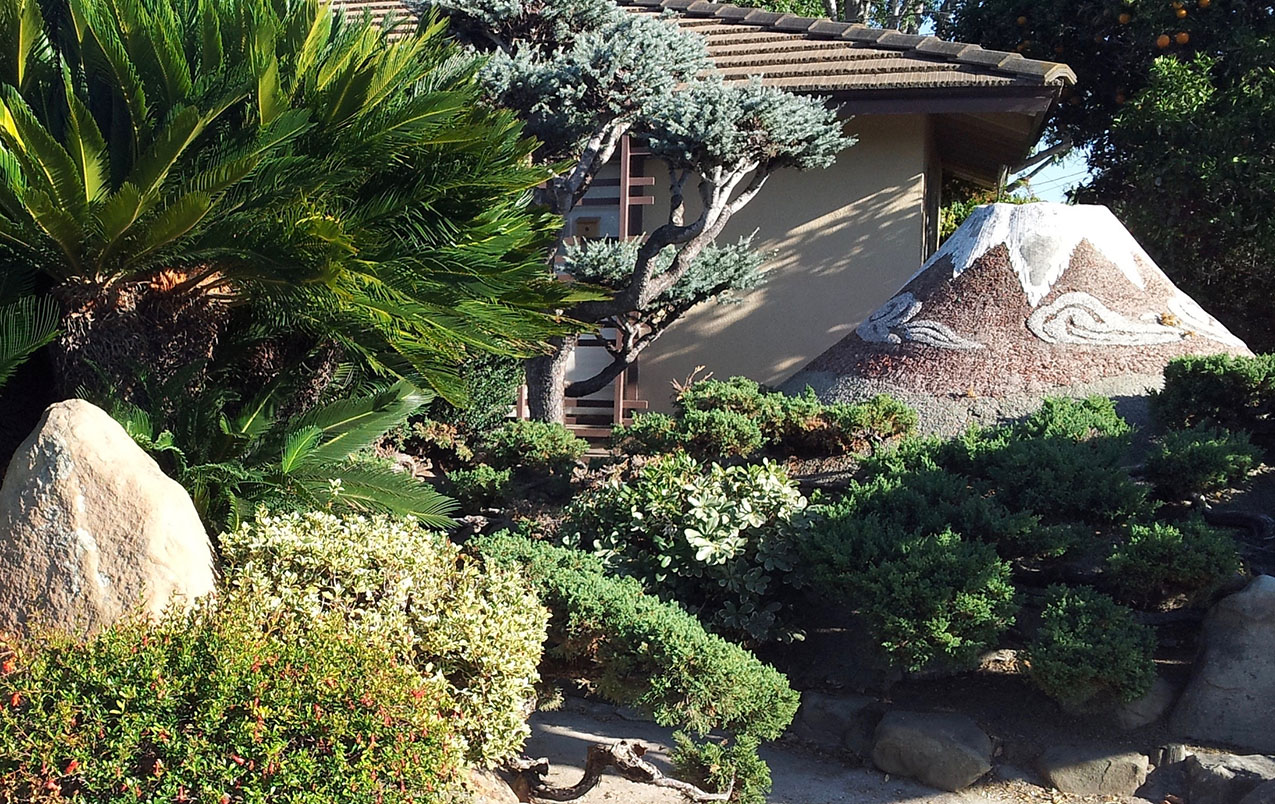
I first saw the garden from a car window in 1966. Astounded, I asked my father to slow down, and made a mental note of how to return. Later, riding past on my bicycle, I sometimes saw the couple that had created the garden. Dressed in dark neat work clothes, their faces shaded by straw hats, they pruned, raked, and tidied so that the garden always looked well tended. I never spoke to the couple. I wish I had, not only to praise the garden’s beauty, but to ask permission to enter.
One day, overcome by desire, I left my bicycle on the sidewalk and followed the path across the moon bridge to the bench. I gingerly sat down, leaned back under the parasol-shaped roof, and gazed at Mt. Fuji. Lacey clouds scudded across its slope. Below the summit, snow lodged in ravines and dusted the ridges. I felt transported, and wondered what it would feel like to have a bird’s-eye view. I did nothing for a moment, alarmed by the thought. Then, on impulse, I clambered up the mountain made of solid concrete. The summit, flat and round, was a perfect seat. Hugging my knees to my chest, clouds swirling below, I gazed into the distance at a sculpted pine amid craggy rocks. Being on the summit felt like magic…
…until the front door of the house opened.
In a panic, I scuttled down the slope, leapt over the low hedge along the sidewalk, and pedaled away on my bicycle. Glancing back, I saw someone watching me from the alcove by the front door. I wish I had returned to apologize and explain that what I did was not meant as disrespect.
My mother didn’t understand why I loved the garden. She acknowledged its fine workmanship and aesthetic, but wasn’t fond of it. She thought it looked out-of-place in the neighborhood.
I didn’t understand my mother’s disapproval. We lived in Patrician Village, a housing tract that, my father told me, was named after the aristocratic class of ancient Rome. In keeping with the Roman theme, every front yard in the tract had an olive tree. I wondered why Italian-themed yards were less out-of-place than the Japanese-themed yard. Was it simply because they lacked a replica of Vesuvius?
Trying to divine my mother’s reasoning, I questioned her about the two kinds of yards. She told me that olive trees were originally from the Mediterranean, which has a climate like Southern California’s, while sago palm, black pine and other plants in the Mt. Fuji garden were originally from Japan or Asia, which does not. Meant to elucidate, her explanation confused me even further. The idea of plants being “from” a certain place was news to me.
In our front yard, I pointed to the white birch across the walkway from the olive tree. “Where’s that from?”
“Europe.”
“What about the bushes with the pink flowers?”
“Indian hawthorn, from Asia.”
“And the grass?”
We had to look that one up. The Bermuda was from Africa. But after all my questions, I still didn’t understand why one type of landscape belonged more than the other. Neither had plants from Southern California. And this made me wonder: What plants are from here? What’s the real landscape of Orange County? What’s the real nature of the place I live?
On my bicycle, I began to explore. I pedaled through miles of housing tracts before the countryside finally began. In no way pristine, much of it was planted with asparagus fields and eucalyptus-edged orange groves, with the hilly areas used as pasture for cattle. But it was land that wasn’t predominantly covered with houses, lawns, shopping centers, and asphalt. Land that still had vestiges of oak woodlands, sage scrub, chaparral, and sycamore-shaded streams. Land that made it possible to imagine what would have been there if most of the indigenous peoples and landscape hadn’t been obliterated.

In the decades that followed, I learned more about the nature of California. I read field guides, hiked, and camped, becoming familiar with California’s native plant communities, from the juniper and piñon pine woodlands of the Mojave Desert to the wildflowers and gnarled mountain ephedra of the Carrizo Plain to the redwood and bay laurel forests of Big Sur. Closer to home in Los Angeles, I treasured the chaparral and riparian remnants that could still be seen among the Southern California sprawl.
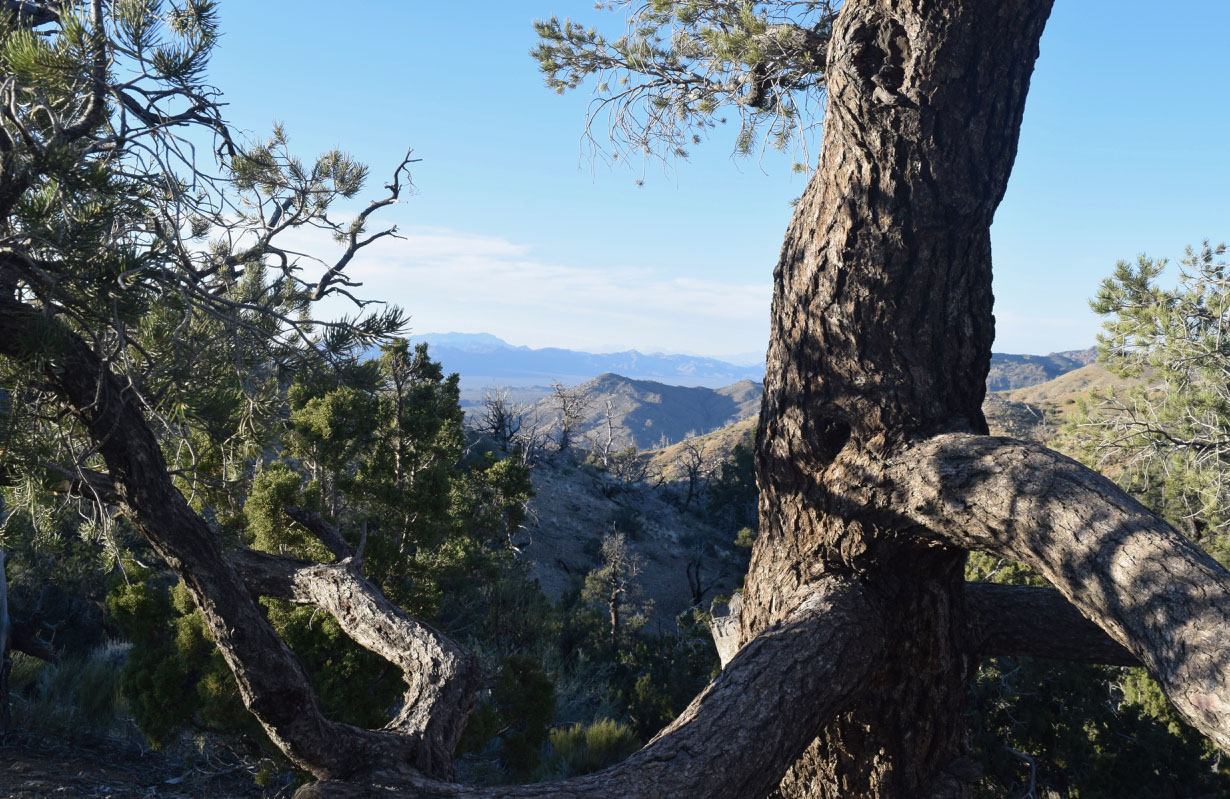
It came as no surprise that the California Floristic Province is one of the most biodiverse and threatened places on Earth—one of 36 designated biodiversity hotspots on the planet. Since the 1700s, the Province has lost nearly 70 percent of its original type of vegetation. From what I’d seen growing up in Orange County, the loss was heartbreakingly easy to understand. My family had been part of it. Population pressure had brought destruction of wildlands, depletion of groundwater, draining of wetlands, and the introduction of invasive species, all of which had combined to wreak havoc on California’s natural landscape and its remarkable number of endemic animals and plants.
And the longer I lived in California, the more I saw the disconnect between the natural landscape and the built environment. To help heal the disconnect, I began doing outreach for a nonprofit foundation dedicated to native landscaping. Native plants are water-thrifty, and they support biodiversity because of their co-evolution with indigenous insects and other animals. Most butterfly species, for instance, have caterpillars that can eat only native plants. Caterpillars matter because they’re the main food of baby birds… But I was drawn to the work for more than mechanistic problem solving: the practice of native gardening creates an essential emotional shift for preserving the biosphere. It teaches us to cherish the nature of the place we live. I hoped that as people honored the nature of California in their gardens, the destruction might slow and the disconnect might become an embrace.
But the disconnect ran deep. An interaction at an Earth Day event in Los Angeles exemplified the chasm: A loud man in pressed slacks and a Polo shirt lingered in front of the foundation’s booth with his two teen-aged sons. On the display tables were nursery containers of blue elderberry, western redbud, chaparral mallow, and showy penstemon, among others.
“California’s a desert,” the man said his sons. “There was nothing here—no trees, nothing—until people came and planted everything.” The man looked at me for confirmation.
After a pause, trying to figure out where to begin, I said, “Only a small part of California is desert. The rest varies from rainforest to chaparral.”
“Well, most native plants are cactus,” the man replied.
“A lot of people have that perception,” I said, “but, actually, only one to two percent are cacti. The rest includes oak, manzanita, and buckwheat, and many other kinds of plants. California has more than 5,000 native species. Some are scented, like this hummingbird sage.”
The man looked unhappy as one of his sons smelled a leaf. With surprise, the son exclaimed, “It smells like pineapple… and mint!”
“Well, none of this would be here if people hadn’t planted it. California was a wasteland until all the people came.”
If I hadn’t been working, I would have said, Do you mean white people? and would have told the man about indigenous stewardship of California’s landscape—stewardship that helped it thrive for millennia until undone by white people in less than three hundred years.
Instead, I forced a smile and said, “You’re not alone in thinking it was a wasteland, but it’s naturally one of the most biodiverse places on Earth. Oaks, for instance, have been in California for ten million years. We know this from the fossil record.”
“Well, people planted everything else,” the man said with finality, and gave me a stern look.
“Dad, what about the sequoias?” said the other son.
The man scowled at me. “I don’t like your tone.” And ushered his family away.
The rest of the day, people came to the booth asking for tropical plants, South African succulents, and French lavender. I offered similar-looking native plants, but most people seemed to value the nature of every place but California.
That evening at dinner, I said to my husband, “I wonder what would it feel like to be in a culture that loves nature—not just nature in general, but the nature of their particular place on Earth?”
“I’m going to a workshop in Kyoto,” my husband said, “Come with me and see.”
I grimaced. “The Japanese kill whales, and the culture’s sexist. I get enough of that here.” I told my husband about the interaction earlier that day.
“At least the man’s sons might have learned something,” my husband said. “As for Kyoto, I still think you’d love the gardens. And the people are unfailingly polite.”
And so, in November 2015, I found myself on the bullet train, passing the real Mt. Fuji. When I saw it, memories of the karesansui garden from my childhood came flooding back. The mountain was as beautiful as the garden had suggested. And though the real mountain was surrounded by a conglomeration of refineries, tile-roofed houses, building cranes, rice paddies, elevated freeways, skeins of high-tension wires, pocket-sized solar arrays and graveyards of polished stone, the mountain’s magnificence was somehow undiminished.
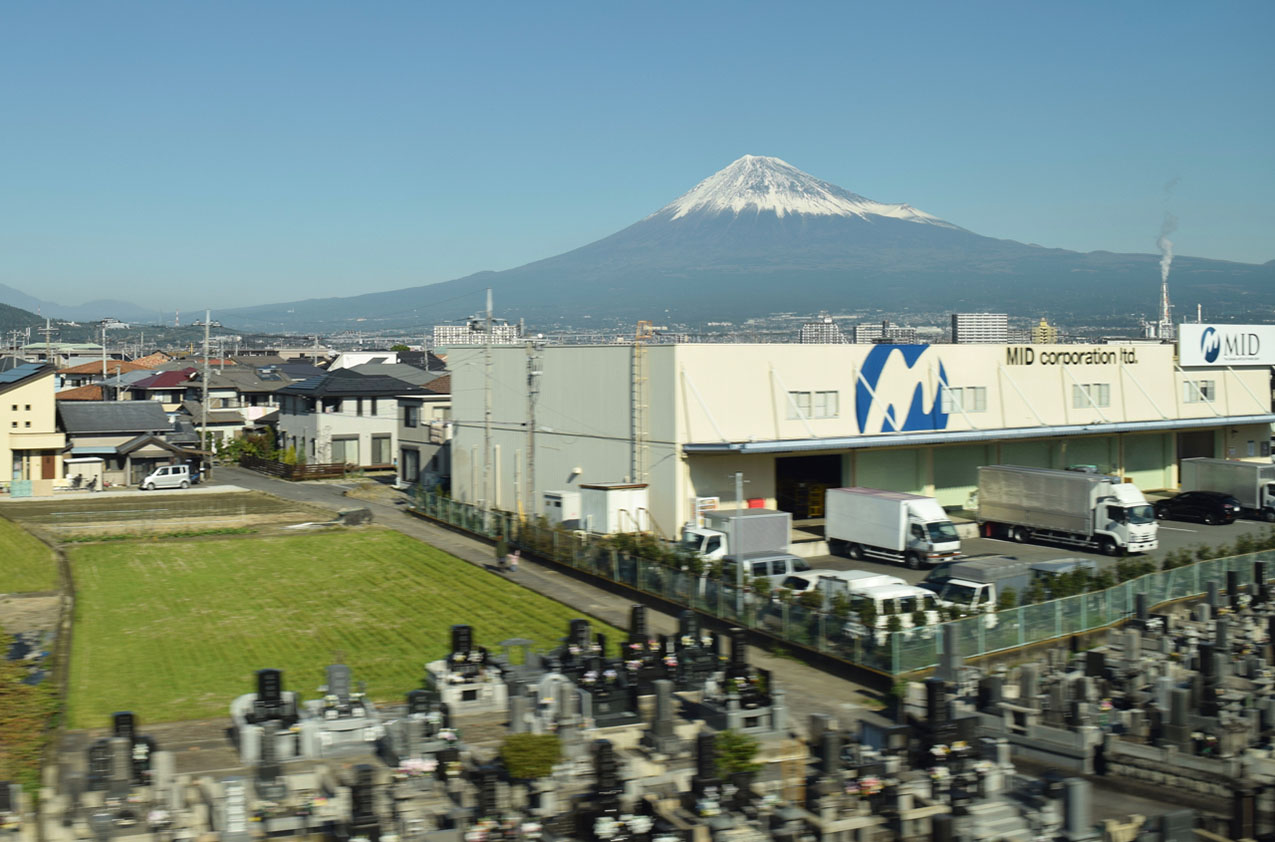
In Kyoto, I rented a bicycle and explored the city. Bundled up against the cold, I pedaled dozens of miles each day to visit some of the city’s 400 Shinto shrines and 1600 Buddhist temples. I wheeled along the Kamo River, where flocks of black kites soared above the riverbanks, hunting and scavenging for food. I coasted through neighborhoods of narrow lanes and even narrower houses, where small pots of well-tended plants greened the miniscule, prized margin between house and street. When I became chilled, I ducked into small shops with worn wooden tables to savor hot green tea and skewers of roasted rice. And the better I got to know the city, the more I was struck by its thousand-plus years of history and sense of place.
In Kyoto’s forested foothills, the shrines embodied serene wild beauty, with towering groves of bamboo, unpolished otsuka stones inscribed with prayers, and meditative stairways through airy tunnels of vermilion red torii. On the pilgrim path from the Kurama-dera temple to the Kibune-jinja shrine in the mountains to the north, I saw an enormous Japanese cedar that rivaled a giant sequoia. The cedar was a yorishiro—a sacred object believed to house a spirit. A hemp rope encircled the trunk of the tree, decorated with tassels and white paper streamers folded to look like lightning; the shimenawa designated the tree as sacred. In fact, shimenawa were everywhere—on rocks, trees, and entrances to spaces—forbidding any interference with the site. Entire skyscrapers had been designed to accommodate the sacred.
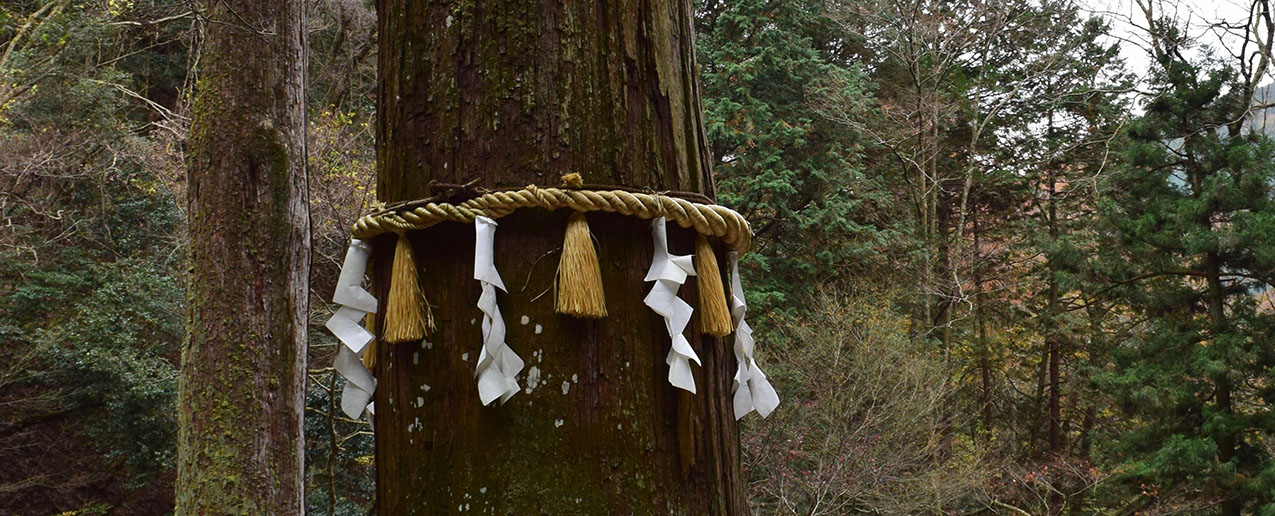
But as much as I was drawn to the shrines, I spent the most time in Buddhist temple gardens. Even in the middle of the city, they looked part of the larger natural landscape. This was no accident: Created from the rocks, trees, gravel, sand, shrubs, and moss of Japan, the gardens were infused with a sense of continuity and place. Echoing the native plant communities of the surrounding mountains, there were maples with red and yellow leaves among black pines… camellias beneath canopies of cedar and elm… and azaleas among carpets of moss. Every garden reflected the nature of Japan. The disconnect I’d come to expect between gardens and the larger natural environment was non-existent. The indigenous landscape, revered and embraced. And in that embrace, there was harmony between landscapes made by nature and landscapes made by people.
The hōjō garden in Nanzen-ji was my favorite. For hours, I sat cross-legged on the wooden veranda overlooking its karesansui niwa as people quietly padded by in socks. At the foot of the veranda was a sea of raked gravel. Across the sea was a slender island of moss. Anchored in the moss were craggy rocks that resembled mountain peaks, with azalea, red pine, and maple that suggested a forest. The maple’s small red leaves looked incandescent against the silver-black tiles of the garden wall and temple roofs behind. As I sat there, I almost wept, thinking, People can create such beauty when they love what they’ve got.
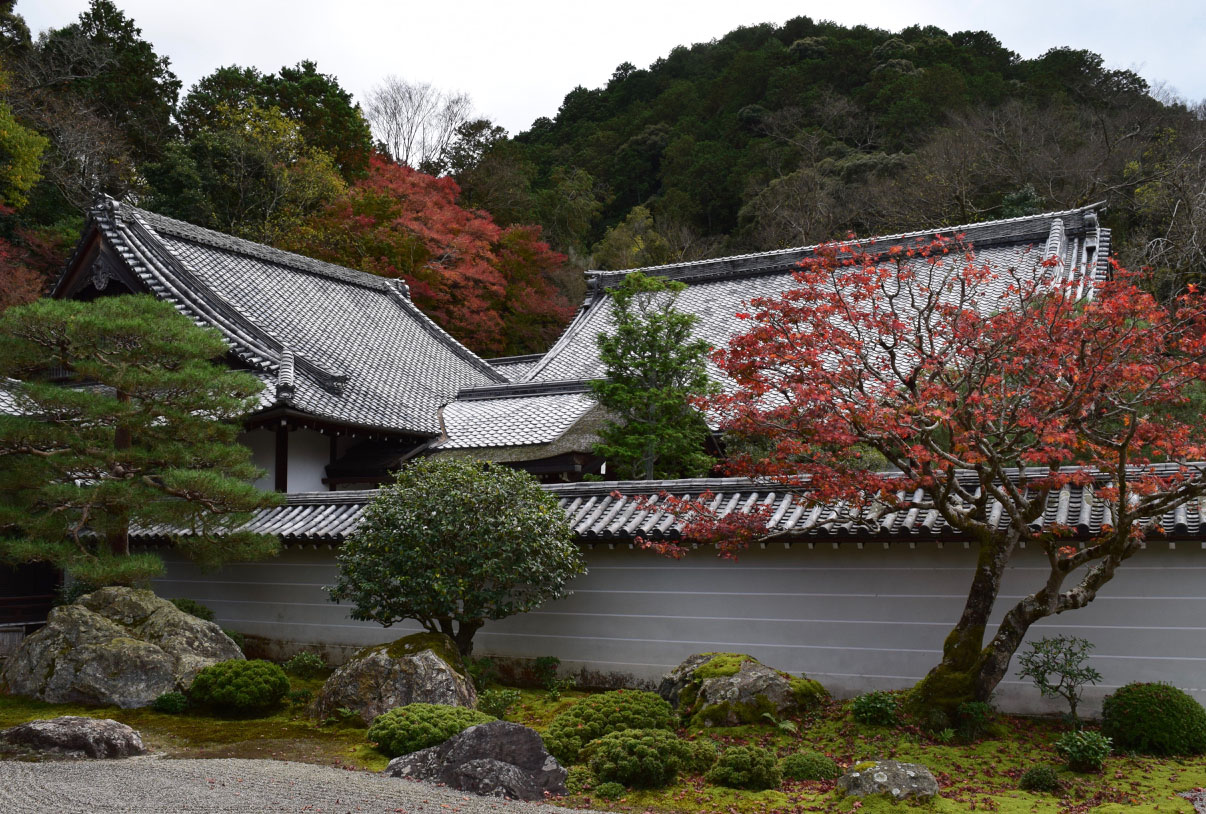
But the one thing about Japan that I truly hadn’t anticipated was the respect shown to its natural areas and gardens. Everywhere I went, there was the press of humanity, and yet there was no graffiti on rocks, no initials carved into trunks of trees, no plants trampled or uprooted. I hadn’t thought it possible that tens of thousands of people wouldn’t harm the very thing they’d come to see.
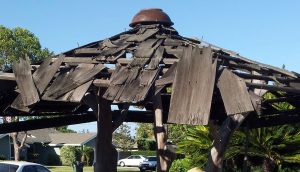 Six months after my return to Southern California, I stopped by the karesansui garden of my childhood. The mountain and the plants were much as I remembered, though much else had changed: The gravel stream was now half dirt. The bright red paint on the moon bridge was faded and chipped, dark brown wood showing underneath. The shingled roof over the bench was a patchwork of sky. A wheelchair ramp now led to the front door of the house. In the side yard, an old battered truck with high plywood sides was gathering dust. It shook me to see the garden in such a state, the beauty that had been so lovingly created now so neglected. I couldn’t help but feel that it must have broken the couple’s hearts to witness the garden falling into disrepair and to have neither the physical fortitude nor, perhaps, the means to intervene.
Six months after my return to Southern California, I stopped by the karesansui garden of my childhood. The mountain and the plants were much as I remembered, though much else had changed: The gravel stream was now half dirt. The bright red paint on the moon bridge was faded and chipped, dark brown wood showing underneath. The shingled roof over the bench was a patchwork of sky. A wheelchair ramp now led to the front door of the house. In the side yard, an old battered truck with high plywood sides was gathering dust. It shook me to see the garden in such a state, the beauty that had been so lovingly created now so neglected. I couldn’t help but feel that it must have broken the couple’s hearts to witness the garden falling into disrepair and to have neither the physical fortitude nor, perhaps, the means to intervene.
I sat in my car and stared at the garden. It was still such an arresting contrast to the other front yards on the block. Despite the decades, they were much the same: Lawns were still dominant, edged with neatly pruned shrubs. In the parkways were eucalyptus from Australia, crape myrtle from Asia, and magnolia from the southeastern U.S. Around the houses, queen palm from South America, bird-of-paradise from South Africa, and lavender from the Mediterranean. The sole exception to these other yards was one with desert willow, white sage, and bladder pod from Southern California. Despite belonging to the larger natural landscape, the garden looked completely out-of-place.
I drove through Patrician Village. The lawns, clipped hedges, and exotic species continued without relief. Only a few of the original olive trees remained; the one in front of my old house had been removed. In the distance, the Santa Ana Mountains were visible, a coastal range of soft foothills around the peaks of Saddleback Ridge. The mountains were dark green, a mix of oak, mountain mahogany, hollyleaf cherry, and laurel sumac, among hundreds of other species. Patrician Village was once greened by many of the same kinds of plants—in all, more than 500 kinds of indigenous trees, grasses, shrubs, vines, succulents, ferns, and wildflowers. I looked at the yards up and down my old street. Not one reflected this former richness. All the yards contained the same few dozen exotic species. The landscape of Patrician Village was deeply impoverished.
But I was bothered by more than just the paucity of the exchange. A second thing shook me that day: Despite the blocks and blocks of greenery, the yards were virtually empty of insect and other animal wildlife. The only butterfly I saw was an import from Europe, the cabbage white. The only birds: sparrows and crows, and some hummingbirds dueling over sugar water from a feeder. I wondered if people in Patrician Village noticed the lack of life, or if they’d become so inured to it they didn’t even perceive what was missing.
Dozens of butterfly species had once called the flatlands of Patrician Village home: duskywings, blues, ringlets, coppers, elfins, and hairstreaks, among others. It was early summer. There should have been flurries of butterflies nectaring and mating, but they were nowhere to be seen. The impoverished landscape had none of the plants the butterflies needed for their caterpillars. And the same lack of food was true for most of the other creatures that had once made this place home, before it became an orange grove and then Patrician Village. Now, only the generalists could survive, like crows, sparrows, and coyotes. And hummingbirds that tried to make do on sugar water when, in the wild, nectar is only 20% of their diet, with insects and spiders making up the rest.
I’d seen enough. Time to join my parents for lunch. I drove toward Irvine, where they now lived in a massive, planned community built around an artificial lake and landscaped almost exclusively with exotic plants. How much more of the natural landscape would have to be obliterated, I wondered, before native gained the cachet of exotic? When, as a culture, would we recognize the awful sterility we have imposed upon the land?
At lunch with my parents, I mentioned that I’d driven through Patrician Village, and described what had become of the karesansui garden. My mother picked up on the sadness in my voice.
“Why do you like that garden?” she said. “It’s not native.”
“It’s not just nostalgia,” I said, somewhat defensively. “I like how the garden cherishes the nature of Japan. You can see that in the entire culture, from motifs in pottery to textiles and graphic art.”
My mother pounced. “So if I cherished the nature of England and made a garden of lawn and roses, you’d like that, too?”
“No, not at all—least of all for the water it would consume. It would be completely out-of-place.”
“But you like the Japanese garden. Isn’t that out-of-place?” My mother settled back in her chair and waited for my response.
I took a sip of water, trying to regroup. “Yes, it’s out-of-place, but I like the idea the garden represents. It’s a holistic idea, with ecological integrity… an idea that integrates the garden into the larger natural landscape. We just need to translate that idea by making gardens of Southern California plants.”
“It’s a free country,” my father quipped. “People can plant what they want.”
“Yes, they can,” I said sharply, “but we’re in an extinction crisis and most yards are ecological wastelands. Irvine’s a hodgepodge of plants from around the world that sustain almost nothing here. It’s green, but it’s starving the food web.”
“It still looks nice,” my father said.
“Don’t you see? It’s a form of ecocide!”
“Okay,” my mother said, “I think we’ve talked about this enough.”
For the rest of the visit, we steered clear of other potential topics of disagreement. Dessert and coffee were followed by a marathon game of pinochle. Mid-afternoon, I headed home toward Los Angeles.
The freeway traffic was moving slowly, though not yet bumper-to-bumper. I was glad to be on my way home, but unsatisfied with my visit. I couldn’t shake the feeling of having unfinished business. An exit appeared near Patrician Village and I took it. I drove parallel to the freeway for a few blocks, then made a couple of turns and pulled up in front of Mt. Fuji.
The house was quiet, the rooms dark, as I walked up the wheelchair ramp. I rang the doorbell and waited, then knocked. Moments later, through the door’s frosted glass, I saw some movement inside the entry hall. The door opened. A young woman in shorts and a t-shirt stood before me, looking wary. Her kind face gave me courage to explain what I was doing on her front step.
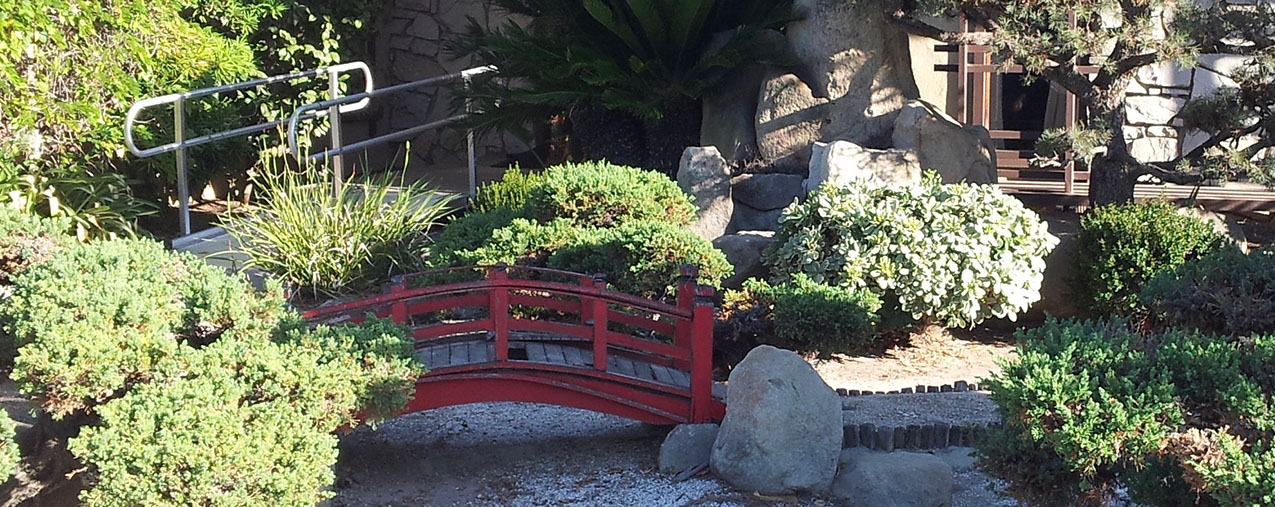
I apologized for disturbing her, and then told her my name and that I’d once lived nearby and had always loved her front garden.
She looked surprised, and smiled. “It’s really nice to hear you say that. Sometimes we think we should just tear it down.”
“Oh, no! It’s beautiful, and it has a history all its own.”
The young woman didn’t reply.
“I’m sorry,” I said quickly, “I don’t mean to tell you what to do.”
“No, it’s not that,” she said, her voice tinged with regret. “The garden was beautiful. We haven’t been able to maintain it. We’re all working, and I’m in school.”
There was an awkward silence. “I have a confession to make,” I said. “When I was a child, I snuck into the garden and sat on top of the mountain. Someone came out of the house, and I ran away.”
The young woman laughed. I think she said it had probably been one of her grandparents. I don’t remember the exact familial connection.
We talked a few more minutes. I mentioned that a colleague of mine had worked at the Japanese American National Museum and might have some ideas about whom to contact for help with the garden.
The young woman’s face brightened. “Some help would really be great.”
She gave me her card. We shook hands. It felt like reaching across decades.
I rejoined the freeway traffic, now bumper-to-bumper, stop-and-start all the way to Los Angeles. Where the freeway rose above the coastal plain, I could see for miles in every direction, the flatlands a vast grid of shopping centers and houses. As nearly everywhere in Southern California, exotic trees lined the streets. Exotic shrubs fringed the parking lots. The greenery around the houses wasn’t much different. Yard after yard of Bermudagrass, queen palms and banana plants, parched and forlorn-looking in the dry summer heat. I felt cross looking at the landscape. Even more so, I felt grief: Grief that so much of its natural integrity had been destroyed. Grief there was so little intimacy with the splendid nature of this place… a place once home to more than 100 species of wildflowers.
Looking out at the flatlands, I thought, just like they’ve done in Japan, we could create our own indigenous aesthetic. We could love this land and provide for its creatures…
And the rest of the way to Los Angeles, I daydreamed about what Orange County gardens could look like: Patios shaded by coast live oak and laurel sumac; oaks support entire communities of wildlife, and laurel sumac’s berries are vital for songbirds.… Hedges made of hollyleaf cherry, sugar sumac, and lemonade berry; the bushes flower in winter and spring, and their fruit feeds birds and small mammals.… No-mow lawns of purple three-awn grass dotted with wildflowers; the grass provides copious amounts of seed, and wildflowers are essential for California’s solitary bees. I imagined patchworks of sage, buckwheat, and mallow…trellises of wild grape…and moon gardens of white sage, chalk dudleya and silver lupine. The possibilities for a bioregional aesthetic seemed endless. And instead of sterile anonymity, the aesthetic would deliver life-supporting authenticity of place.

That night, I dreamed the karesansui garden had been restored—the moon bridge painted, the shingled roof repaired, the gravel stream replenished and raked. I also dreamed that, for blocks and blocks around it, indigenous gardens honored the nature of Orange County. Wish fulfillment, I know. Yet, when I woke, I knew the dream could be real. Again and again, people have come together to help one another and their community. And if the idea of community encompasses the native plants of the region, we not only rekindle biodiversity around us, but cultivate love and reverence for our particular place on Earth.



